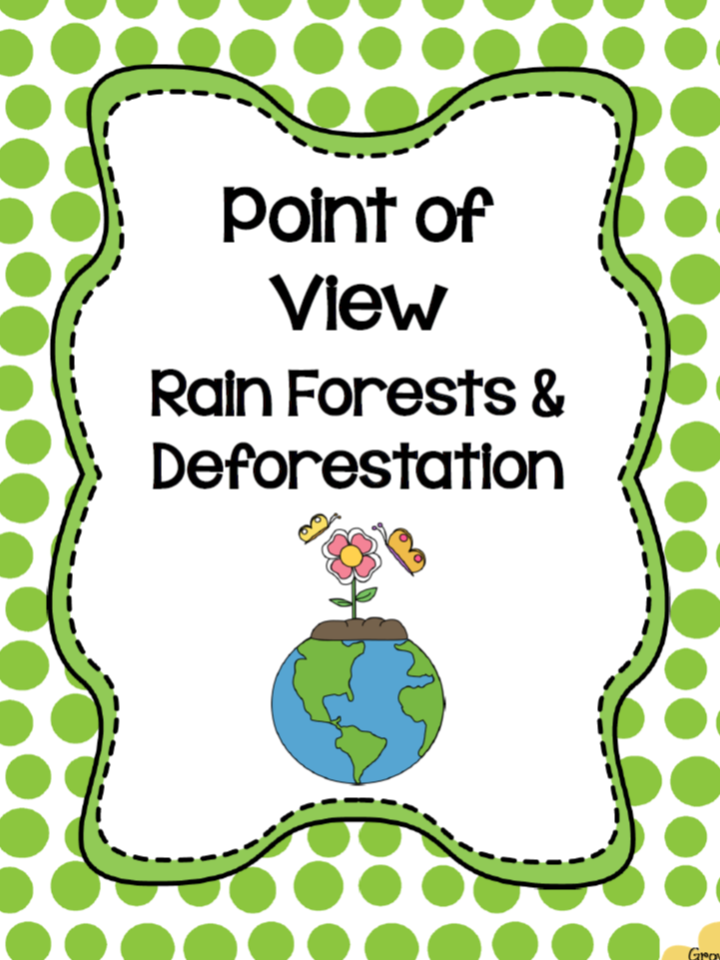My students and I had been having fun with Point of View in fiction (which I will talk about in another blog), but we hadn't really talked much about it in a non-fiction context. I was a little nervous because to teach Point of View in non-fiction, since I would have to find a somewhat "controversial" topic... insert visions of phone calls from upset parents... so, what to do for a toned-down, high-interest topic. Enter, The Rain Forest. Now, I know what you're thinking. What two sides can you actually take with the rain forest: don't cut it down and cut it down? No, actually, when I taught World Geography in high school and studied the rain forest in more depth, I learned that there are MANY voices in the rain forest debate. It's much more multi-faceted than young students are led to believe. So, I decided to experiment and see if my third graders would be able to see other points of view related to the rain forest issue, besides the obvious one. In the meantime, we would practice our non-fiction reading strategies, present what we learned, and become informed on this important topic.
We started with a trusty KWL chart. You'd be surprised at how much kids already know about rain forests! After activating our prior knowledge, we read a short chapter book that introduced the students to the basics of rain forests. This way I knew we were all on the same page. I had already taught the basic non-fiction reading strategies (graphic/text features, text structure, main idea/details, etc.), so reading the chapter book together gave everyone a chance to practice these strategies in context. We read Secrets of the Rain Forest, by Edward Myers, which is part of our Good Habits Great Readers series.
 |
| Click the picture to be taken to more information about this book. |
Of course, this not the only book good for this purpose. I just ordered a class set of the Magic Tree House non-fiction companion to Afternoon on the Amazon called Rain Forests. Its a GREAT book that would accomplish the same purpose.
After reading the chapter book, I had students summarize their learning in a Rain Forest Brochure that you can get from my TpT store. These were great to show off at Parent Teacher Conference!
Of course, the last chapters of these books focus on the problem of deforestation. Once I convinced the students that there might be a reason for cutting down a tree or two, I split them into four groups - one at each table. Each group was then responsible for reading, understanding, and discussing an interest group's point of view on deforestation. I chose only four to keep it simple: Environmentalists, Native Amazonians, Ranchers, and Government Leaders. (The posters I used, which are written in first person, are available in my TpT store. I laminated one set and made a copies for each student to record their thoughts.)
After 10 minutes, I had the groups rotate tables until all four groups had a chance to read each poster. I heard great discussions at each table! The kids, especially my "little rebels," loved being the devil's advocate when other students demanded that every tree be saved. "What about jobs for the people of Brazil?" they would say. LOVE it! :)
At the end of the unit, we wrote an Opinion Paper on OUR point of view on deforestation using information from the posters and the books we read. I'm happy to report I still have a class full of aspiring tree-huggers, but now I think they own their opinion. They understand why they believe what they believe and appreciate the complexity of our world's problems a little more than they did when we started. Mission accomplished!
Let me know if you try this activity with your students. I'd love to hear how your kiddos responded!
 |
| Click above to go to my TpT store. |
 |
| Click above to go to my TpT store. |
At the end of the unit, we wrote an Opinion Paper on OUR point of view on deforestation using information from the posters and the books we read. I'm happy to report I still have a class full of aspiring tree-huggers, but now I think they own their opinion. They understand why they believe what they believe and appreciate the complexity of our world's problems a little more than they did when we started. Mission accomplished!
Let me know if you try this activity with your students. I'd love to hear how your kiddos responded!

No comments:
Post a Comment